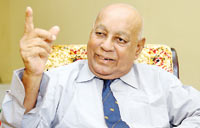As Bloomfield continues to blossom at 125, Wickey reminisces on its achievements

D.P. Wickremarachchi
On the eve of the Club’s 125th anniversary, Bloomfield Cricket and Athletic Club’s D.P. Wickremarachchi, probably the oldest living cricketer, with a membership of over 60 years, and popularly known as ‘Wickey’, spoke to the Sunday Times of the Club’s proud history. Wickey traced the Club’s journey which started in 1893 from the Chalmers Granaries in Pettah via Campbell Park to its present location at Reid Avenue, Colombo 7. A complete Bloomfielder who has served the Club in every capacity as Cricketer, Vice President, Vice Patron, Committee member, Cricket Manager and Coach.
Having to vacate its premises in Pettah, this century-old club moved to Campbell Park in 1922. A patch of green opposite Wesley College grounds, which could only be used for practices. The Club house was a caravan of a small wooden cottage on wheels.
Moving from Campbell Park to Reid Avenue, Bloomfield went from strength to strength as the small man’s Club. Fans in their numbers gathered at every venue where Bloomfield played. The Club had crowd-pulling cricketers who entertained them with swashbuckling batting displays, high quality bowling and acrobatic fielding.
According to Wickey, Bloomfield has won all the tournaments in all 3 Divisions from Sara Trophy to Daily News. In the early days, Bloomfield was the only Club where all 3 Division players practised together, enabling the newcomers, novices and the nondescripts to move and mix with the senior and national players. In its championship march which started in 1923, when it became ‘Club Champions’ under L.N. Joseph, it went on to win every Cricket tournament conducted by the then Board of Control for Cricket in Ceylon and later by Sri Lanka Cricket such as the Daily News, Saravanamuttu, Maharaja, Browns, Honda, Lakspray, Bristol and Hatna Trophies.
The proudest moment in the Club’s history was winning the P. Saravanamuttu Trophy – the Blue Riband of Ceylon Cricket’ in 1963-64, under the late Noel Perera. with only two players who had ‘occasionally’ represented Ceylon – Dhanasiri Weerasinghe and Norton Frederick, the Club on wheels led all the leading clubs of that era. As a member of that champion side, Wickey said the secret behind that great victory was sheer determination, excellent teamwork and unrelenting practice. Wickey recalled that the Club’s progress was due to the unity among the players and officials from its inception, adding that Bloomfield has produced 47 national cricketers and 6 national captains since gaining test status.
The Golden era of Bloomfield Cricket was from 1975 to the unfortunate South African tour in 1982. Six of the Club’s best players were felled by the Club as well as by the country for making the tour. More than half the national side were from Bloomfield
A notable feature of the Club was how the then national players guided the youngsters and instructed them to play with a straight bat. The cricketers were very close to their supporters and never failed to have a word or two with them. He lamented the absence of the coordination, dedication and the connection that the cricketers had those days, which are no more. As money plays a big part in present day cricket, a player puts money before the club, and that was the very reason players switch clubs every season.
Having joined the Club in 1956 as a schoolboy, Wickey represented the Club in all 3 Divisions in that era, which was the Saravanamuttu, Donovan Andree and Daily News Trophies. This veteran Bloomfielder goes on to say that even though he joined as a schoolboy, the senior players never made him feel like a junior, and he enjoyed his cricket at the Club till his retirement. The coordination among the cricketers of the earlier days was the force behind every victory. After his playing days were over, Wickey, apart from the many honorary duties he did in many capacities, took charge first as cricket coach, then as the manager and lastly cricket secretary.
He continued to stay as his duties were made easy by the support and coordination of the cricketers who were a dedicated lot. Their main aim was a win for the Club. After a day’s play, the team would sit together and analyse the day’s play and plan for the next day. In conclusion, Wickey paid a glowing tribute to the late Shelley Wickremasinghe who spared no efforts to keep the Club going during difficult times and for being a pillar of strength to the Club. He was a father figure to the cricketers. If not for his unsparing efforts, Bloomfield would never be at its present location in Kurunduwatta.


